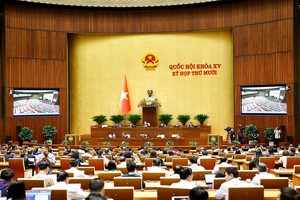Citigroup economists have coined a new concept called 3G, or Global Growth Generators. Vietnam tops the 3G list, which is based on the weighted average of six growth drivers namely investment, demographic prospects, health, education, quality of institutions and policies, and trade openness.
Vietnam’s investment rate, expected high growth rate and large population are among factors making the country top of the 11 nations in the list, Citi economists Willem Buiter and Ebrahim Rahbari wrote in their report report dated Feb. 21.

Global financial services firm Citigroup identified the 11 countries which have the most promising growth prospects as, in alphabetical order, Bangladesh, China, Egypt, India, Indonesia, Iraq, Mongolia, Nigeria, the Philippines, Sri Lanka and Vietnam. The economists say the nations have highest growth potential in the 21st century.
The report added that the new concept offers hope for countries ignored by other more traditional lists that focus on emerging markets.
Vietnam scores 0.86 on the 3G index. China is second with 0.81, followed by India’s 0.71, Indonesia’s 0.70, Mongolia’s 0.63, the Philippines’ 0.60, Iraq’s 0.58, Bangladesh’s 0.39, Egypt’s 0.37, Sri Lanka’s 0.33, and Nigeria’s 0.25
“Vietnam’s expected growth rate of real per capita GDP between 2010 and 2050 is 6.4 percent, according to our projections,” the authors wrote. “This growth is expected to come from a very low base – Vietnam starts from the 55th position in our rankings in the real per capita GDP rankings with a 2010 figure of $3,108.”
Vietnam’s population is expected to increase from 89 million in 2010 to 112 million in 2050, according to the report. Its working age population is expected to grow until about 2035, when it is projected to be 17.4 percent larger than in 2010.
Citi said the Southeast Asian country’s investment rate, at 35 percent of GDP during the years 2006-2009, should be high enough to sustain significant growth.
Regarding Vietnam’s weaknesses, the report reads, “Its institutional quality is low and its macroeconomic policies, including its exchange rate management, have been erratic.”
Other weaknesses include sizable external imbalances and a rising level of public debt.
However, the report wrote, “In our view, many of the challenges can be overcome relatively easily. Feasible improvements in institutional quality and in the efficiency of the capital accumulation process should make our projected growth rates achievable.”
Notably, the authors wrote that China should overtake the US to become the largest economy in the world by 2020, then be overtaken by India by 2050.
The two Citi economists added, “For poor countries with large young populations, growing fast should be easy: open up, create some form of market economy, invest in human and physical capital, don’t be unlucky and don’t blow it. Catch-up and convergence should do the rest.”
They said developing Asia and Africa will be the fastest growing regions, in their view, driven by population and income per capita growth, followed in terms of growth by the Middle East, Latin America, Central and Eastern Europe, the CIS, and finally the advanced nations of today.
Citi said it sees strong global growth until 2050, with an annual average of 4.6% until 2030 and 3.8% until 2050.
























